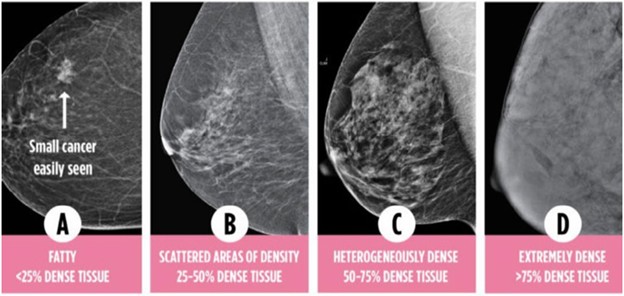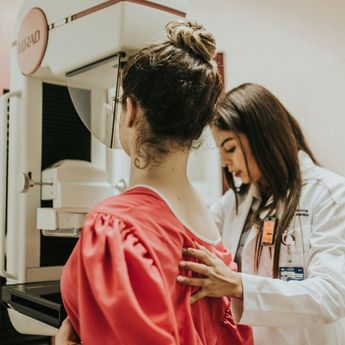By continuing to use our site, you consent to the processing of cookies, user data (location information, type and version of the OS, the type and version of the browser, the type of device and the resolution of its screen, the source of where the user came from, from which site or for what advertisement, language OS and Browser, which pages are opened and to which buttons the user presses, ip-address) for the purpose of site functioning, retargeting and statistical surveys and reviews. If you do not want your data to be processed, please leave the site.
The Voice of People With Breast Cancer
Information
Breast Cancer Basics
Understanding Risk Factors
Dense Breasts
Breast density refers to the amount of fibrous and glandular tissue compared to fatty tissue in the breast. It can’t be felt or seen—only a mammogram can determine it. Nearly half of women aged 40 and older have dense breasts.
What Makes Breasts Dense?
Breasts are made up of:
- Fatty tissue, which gives shape and size
- Glandular tissue, which includes ducts and lobules
- Fibrous tissue, which supports the breast structure
Breasts are considered dense when they have more fibrous and glandular tissue than fat. People with very dense breasts (75% or more dense tissue) are 4 to 6 times more likely to develop breast cancer.
What Affects Breast Density?
Breast density is influenced by:
-
Age (usually decreases with age)
- Pregnancy, childbirth, and menopause
- Hormone therapy (can increase density)
- Tamoxifen (can reduce density)
- Low BMI
- Alcohol use
- Ethnicity (e.g., Asian women often have denser breasts)
- Genetics
- Smaller breast size
You can’t feel breast density—it’s only seen on a mammogram.
How Is Density Measured?
A mammogram is the only way to assess breast density. In Canada, most imaging centres use the American College of Radiology’s Breast Imaging Reporting and Data System (BI-RADS) classification:
- A: Mostly fatty
- B: Scattered dense areas
- C: Even mix of dense and fatty tissue
- D: Extremely dense (highest risk)
Breast Density classifications by Dense Breasts Canada
Breast Density and Cancer Risk
People with dense breasts (especially BI-RADS C or D) have a higher risk of breast cancer—similar to having a first-degree relative with the disease. While dense breasts raise risk, they don’t mean you’ll get cancer.
Breast Density and Mammograms
Dense tissue appears white on a mammogram—just like tumours—which makes cancer harder to detect. In very dense breasts (BI-RADS D), mammograms can miss up to 70% of cancers.
If you have dense breasts, your care provider may suggest extra tests:
- Ultrasound: Helps evaluate dense areas
- MRI: Most sensitive for dense breast tissue
- 3D Mammogram (Digital Breast Tomosynthesis): More accurate than standard 2D imaging
Click here to learn about screening in your area.
Related reading from Our Voices Blog:
Does Breast Density Affect Treatment?
Breast density doesn’t change how cancer is treated or the chances of survival. But it’s important to understand how it impacts risk and the accuracy of screening.
Learn More
For more on screening and advocacy, visit our advocacy guide.
Medical Review by Roochi Arora, MD, FRCPC, August 2025
- References
-
Breastcancer.org. (2025). Alcohol and breast cancer risk. https://www.breastcancer.org/risk/risk-factors/drinking-alcohol
Canadian Breast Cancer Network. (2022). Breast cancer and you: A guide for people living with breast cancer [PDF]. https://cbcn.ca/web/default/files/public/
Reports/Breast%20Cancer%20and%20You_
ENG_edit_web.pdfCanadian Cancer Society. (2024). Breast density. https://cancer.ca/en/treatments/tests-and-procedures/mammography/breast-density
Centers for Disease Control and Prevention. (2023). About dense breasts. https://www.cdc.gov/breast-cancer/about/dense-breasts.html
Conner, K. (2024). Dense breasts. Breastcancer.org. https://www.breastcancer.org/risk/risk-factors/dense-breasts
Dense Breasts Canada. (n.d.). Breast screening advocacy toolkit: Getting the breast screening you need [PDF]. https://densebreastscanada.ca/wp-content/uploads/2024/03/DBC-Advocacy-Guide-draft-11_optimized.pdf
Hussein, H., Abbas, E., Keshavarzi, S., Fazelzad, R., Bukhanov, K., Kulkarni, S., Au, F., Ghai, S., Alabousi, A., & Freitas, V. (2023). Supplemental breast cancer screening in women with dense breasts and negative mammography: A systematic review and meta-analysis. Radiology, 306(3), e221785. https://doi.org/10.1148/radiol.221785
Kleinknecht, J. H., Ciurea, A. I., & Ciortea, C. A. (2020). Pros and cons for breast cancer screening with tomosynthesis - A review of the literature. Medicine and Pharmacy Reports, 93(4), 335–341. https://doi.org/10.15386/mpr-1698
My Breast Screening. (2024). Your comprehensive guide to breast cancer screening in Canada. https://www.mybreastscreening.ca/wp-content/uploads/2024/07/DBC-Screening-Guide_draft15_optimized.pdf
National Cancer Institute. (2024). Dense breasts: Answers to commonly asked questions. National Institutes of Health. https://www.cancer.gov/types/breast/breast-changes/dense-breasts
Thigpen, D., Kappler, A., & Brem, R. (2018). The role of ultrasound in screening dense breasts - A review of the literature and practical solutions for implementation. Diagnostics (Basel, Switzerland), 8(1), 20. https://doi.org/10.3390/diagnostics8010020
SHARE





